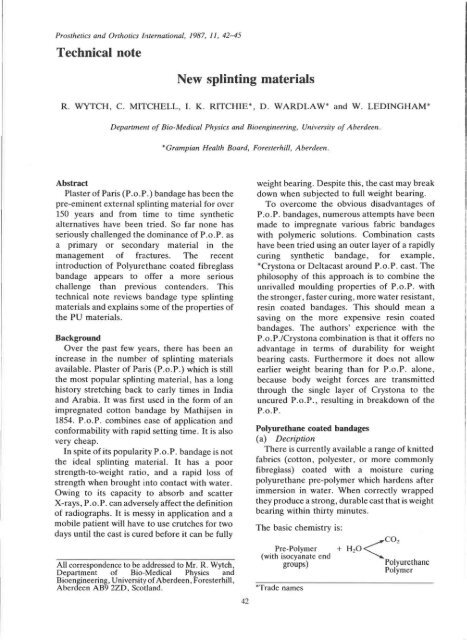View Complete Issue PDF
View Complete Issue PDF
View Complete Issue PDF
Create successful ePaper yourself
Turn your PDF publications into a flip-book with our unique Google optimized e-Paper software.
Prosthetics and Orthotics International, 1987, 11, 42-45<br />
Technical note<br />
New splinting materials<br />
R. WYTCH, C. MITCHELL, I. K. RITCHIE*, D. WARDLAW* and W. LEDINGHAM*<br />
Department of Bio-Medical Physics and Bioengineering, University of Aberdeen.<br />
*Grampian Health Board, Foresterhill, Aberdeen.<br />
Abstract<br />
Plaster of Paris (P.O.P.) bandage has been the<br />
pre-eminent external splinting material for over<br />
150 years and from time to time synthetic<br />
alternatives have been tried. So far none has<br />
seriously challenged the dominance of P.o.P. as<br />
a primary or secondary material in the<br />
management of fractures. The recent<br />
introduction of Polyurethane coated fibreglass<br />
bandage appears to offer a more serious<br />
challenge than previous contenders. This<br />
technical note reviews bandage type splinting<br />
materials and explains some of the properties of<br />
the PU materials.<br />
Background<br />
Over the past few years, there has been an<br />
increase in the number of splinting materials<br />
available. Plaster of Paris (P.o.P.) which is still<br />
the most popular splinting material, has a long<br />
history stretching back to early times in India<br />
and Arabia. It was first used in the form of an<br />
impregnated cotton bandage by Mathijsen in<br />
1854. P.o.P. combines ease of application and<br />
conformability with rapid setting time. It is also<br />
very cheap.<br />
In spite of its popularity P.o.P. bandage is not<br />
the ideal splinting material. It has a poor<br />
strength-to-weight ratio, and a rapid loss of<br />
strength when brought into contact with water.<br />
Owing to its capacity to absorb and scatter<br />
X-rays, P.o.P. can adversely affect the definition<br />
of radiographs. It is messy in application and a<br />
mobile patient will have to use crutches for two<br />
days until the cast is cured before it can be fully<br />
weight bearing. Despite this, the cast may break<br />
down when subjected to full weight bearing.<br />
To overcome the obvious disadvantages of<br />
P.o.P. bandages, numerous attempts have been<br />
made to impregnate various fabric bandages<br />
with polymeric solutions. Combination casts<br />
have been tried using an outer layer of a rapidly<br />
curing synthetic bandage, for example,<br />
*Crystona or Deltacast around P.o.P. cast. The<br />
philosophy of this approach is to combine the<br />
unrivalled moulding properties of P.o.P. with<br />
the stronger, faster curing, more water resistant,<br />
resin coated bandages. This should mean a<br />
saving on the more expensive resin coated<br />
bandages. The authors' experience with the<br />
P.o.P./Crystona combination is that it offers no<br />
advantage in terms of durability for weight<br />
bearing casts. Furthermore it does not allow<br />
earlier weight bearing than for P.o.P. alone,<br />
because body weight forces are transmitted<br />
through the single layer of Crystona to the<br />
uncured P.o.P., resulting in breakdown of the<br />
P.o.P.<br />
Polyurethane coated bandages<br />
(a) Decription<br />
There is currently available a range of knitted<br />
fabrics (cotton, polyester, or more commonly<br />
fibreglass) coated with a moisture curing<br />
polyurethane pre-polymer which hardens after<br />
immersion in water. When correctly wrapped<br />
they produce a strong, durable cast that is weight<br />
bearing within thirty minutes.<br />
The basic chemistry is shown in the diagram.<br />
*Trade names
















